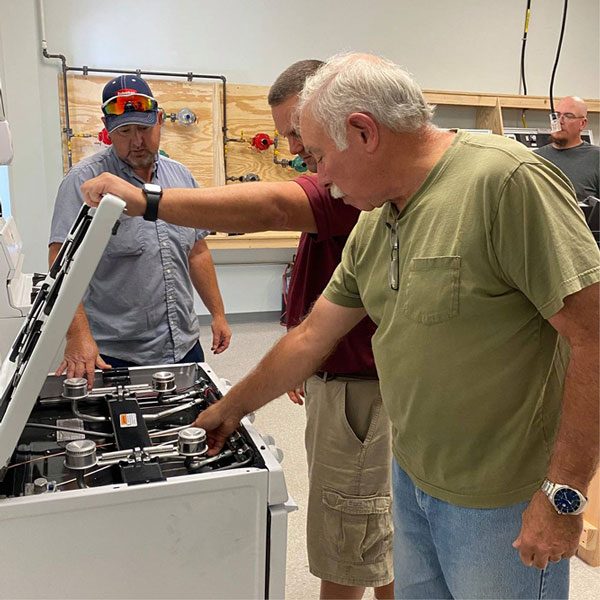
The need for education programs that provide specified, high-quality training targeted toward trade jobs is becoming increasingly profound. To find out how the Pennsylvania Petroleum Association (PPA) is looking to answer the call to that very need in its Pennsylvania Petroleum Association Technical Education Center (PPATEC), BPN spoke with PPATEC Executive Vice President Ted Harris on the unique offerings of the program and the rewarding work it is doing for those looking for growth opportunities in the world of propane and other trade careers.
1. How did the idea to create PPATEC come about? What needs is the program seeking to address?

PPA has been offering technical training for industry stakeholders since the 1980s with a primary focus on oil-fired equipment. A common pain point that we heard from our members is the broader workforce development challenge the industry is facing for developing the next generation of field technicians and drivers as the current workforce continues to retire. Our board of directors identified this as an action item the association should act on. In 2018, the PPA established a strategic plan to expand and diversify the association’s technical training program. This included a few primary initiatives:
- Brand creation — Establish the PPATEC brand to separate the training operation from PPA association activities. This standalone brand also included the creation of a dedicated website (ppatec.com) exclusively for technical training messaging and class registration activities. The PPA also created a new membership category for PPATEC to attract nontraditional companies to our association that have direct interests in our trade school.
- Building modification — Renovate the association’s training center to double the size of our technical training space. The renovation ultimately added 20-plus new air conditioning, electric and propane-fired systems for hands-on training purposes. A second classroom was also added as a part of the renovation.
- Program diversification — Expand the association’s technical education offerings beyond the traditional classes. This specifically included establishing our HVAC & Energy Professional Program that would allow individuals with little or no experience to attend PPATEC as a formal training pathway to start their career as a technician. This new program is approved by the Pennsylvania Department of Education State Board of Private Licensing Schools and the U.S. Department of Veterans Affairs to accept GI bill benefits.
2. What have been some of the biggest challenges in launching and operating PPATEC? What has been helpful in addressing those challenges?
Our industry is competing with other industries in a job market that has the lowest unemployment rate (3.4% in Pennsylvania) since the statistic started being tracked by the state in 1976. Finding quality candidates to attend our HVAC & Energy Professional Program has been one of our biggest ongoing challenges in getting the concept off the ground and established.
However, the model of our trade school is unique, which has helped us separate ourselves from other post-secondary schools. We are one of the only Pennsylvania Department of Education private-licensed schools in the state that is owned and operated by a not-for-profit trade association. This gives us two distinct advantages.
The first advantage is any unemployed student who attends our program is able to leverage the 450-plus companies that are members of our trade school to help in their job placement. A lot of the candidates that we speak to understand this value proposition. We have also been able to follow through on this value proposition by operating with a 95% employment rate since launching the HVAC & Energy Professional Program.
Second, our program is also built as a formalized training program for our employers if they hire a candidate with limited industry experience. For this reason, our trade school can continue to exponentially grow if we have employers who are recruiting for their organizations with the intention of sending their new hires to PPATEC for formalized training.
3. About how many students are current employees versus those looking to start a new career? How is the program experience different for those two groups?

We have experienced approximately a 50/50 split to date for students who are attending our HVAC & Energy Professional Program. As a trade association, this is an ideal ratio that shows strong engagement by members who are making the financial decision to send their employees through the program. We are also seeing strong interest in the students who are seeking employment upon graduation. Some of those students receive multiple job offers prior to graduation.
The 10-Week HVAC & Energy Professional Program is intended to provide basic foundational training for someone with little or no industry experience. In most cases, the students who attend this program have less than six months’ experience. Some have no experience. Most of our students are in the same boat of being novice, resulting in a relatively uniform experience.
4. How involved is PPATEC in where students end up landing in the workforce after their time in the program? What does that process usually look like between the student, PPATEC and hiring companies?
Our program was built by the industry to attract, train and ultimately employ the next generation of skilled technicians. We would not be fulfilling our mission to our membership and students if we were not heavily involved in connecting the two together.
Our job placement process starts prior to the first day of the class. We ask “for hire” students to complete a questionnaire as part of their onboarding orientation. That questionnaire defines their preferred geographic location of employment and what specific job functions they are interested in.
PPA members receive information about these candidates and are able to schedule interviews. Once the 10-week program begins, our association coordinates the employer-student interviews at the school. Students will then receive offers from employers while still in school.
Students are encouraged to decide on their employer a few weeks prior to graduation to allow for enough time to complete the hiring process. It has been normal for most of our students to graduate on Friday and begin their job the following Monday.
5. Can you describe the process of working with companies in various industries? Have you found that companies usually initiate coming to PPATEC for training resources, or does PPATEC have an outreach strategy?
The PPA is engaged in multiple aspects of the energy industry, including sectors that have no direct connection to the classes we offer at PPATEC. This makes our membership messaging and communication strategy complex. A lot of our industry employers are also operating very diversified businesses. We often find that the owner of Company XYZ might not necessarily be the person making the decisions on training, so effectively communicating to all the appropriate contacts within an organization is crucial.
Most of our communication strategy is electronic. The PPATEC website is streamlined to coordinate the entire registration process. Communication that goes to industry stakeholders is through recurring email marketing with a high level of segmentation.
Eighty percent of our training activity is not associated with our 10-week HVAC & Energy Program, which means we host shorter classes that range from one to 10 days in length. These classes are specifically built for employers who want their employees to receive specialized training and industry certification. We differentiate our trade school by offering fundamental hands-on training solutions that aren’t manufacturer-specific. The growth of PPATEC in the past few years is due to this segment of employers continuing to use our program as they develop their teams.
We take a great deal of pride in ensuring the value is there for employers to continue to make the investment to send employees in the future. If we can get a company to send one employee to PPATEC, then there is normally a high probability that the second and third employee will follow.
The other 20% of our training activity is associated with the 10-week HVAC & Energy Professional Program. We held our pilot program in July 2022. This has been a new concept for our membership and industry. Our outreach strategy for this concept is challenging employers to rethink their hiring process. We strongly believe that our industry should view other skilled trade sectors as the real competitor in this space as opposed to another energy marketer located down the street. Our outreach strategy to the industry has encouraged companies to hire talent and develop skills to use PPATEC as a partner to assist in their onboarding effort.
6. What is the most rewarding aspect of working in PPATEC?
On a professional level, it has been rewarding to execute a business plan from concept to implementation. Our association identified an industry need and deployed resources to help improve it for the betterment of our membership. There is no finish line for continuing to expand our workforce development initiatives, but the PPA has made a measurable impact since committing to this initiative six-plus years ago, which I am very proud of.
On a personal level, it has been the positive impact PPATEC has had on students who attend the HVAC & Energy Professional Program. Our students come from different places prior to entering our program, but they all share the same exciting upside upon graduation: They are finding great-paying jobs with our member companies and are on their way to beginning family-sustaining careers in the energy industry. Their gratitude for the opportunity is not something we accounted for our in strategic plan, but is by far the most rewarding.


